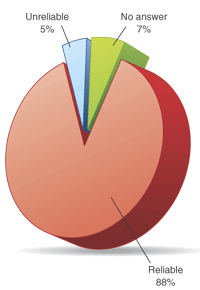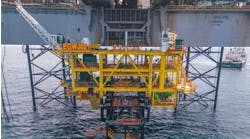Alfa Laval survey reports good reliability for plate heat exchangers
Alfa Laval survey reports good reliability for plate heat exchangers
Plate heat exchangers were first intro-duced to the oil and gas industry in the 1960s, and now represent a signi-ficant portion of all heat exchangers used by the sector worldwide. Many, however, still consider this a "new" technol-ogy, a tag that implies something unproven and with an element of risk.
In 2002–2003, Alfa Laval commissioned a study to provide neutral documentation detailing the reliability of its plate heat exchangers as used in offshore topsides production processes. The survey was conducted in cooperation with the Institute of Technology at Lund University in Sweden, and was based on feedback from process engineers and maintenance personnel on 174 installations. These included 309 plate heat exchangers on platforms in the USA, UK, Norway, Denmark, the Netherlands, Brazil, Australia, China, and West Africa.
The units were all operating in topsides oil and gas production, mainly in crude oil dehydration, secondary cooling, gas compression, and gas dehydration. Of the installations surveyed, 67% featured gasketed units, 24% semi-welded units, and 9% were fully welded.
The survey adopted the Maintenance Terminology European Standard definition of reliability, namely the ability of an item to perform a required function under given conditions over a set period – in other words, to function without faults developing. It was left to each process engineer or maintenance manager to determine whether the individual plate heat exchanger encountered any faults or not.
null
The installations surveyed were between nine months and 25 years old. The estimated aggregated time in service for all the units amounted to 1,933 years, corresponding to nearly 17 million hours in service. Ninety-five percent of the installations are still in operation, and 16% had been in operation for 10 years or more at the time of the survey.
Despite the wide scope of the definition of failure used as the basis for the survey, fault rates were low. Incidents were reported on only 51 installations, and there were only 104 registered incidents during a combined 17 million hours in service.
Faults can be detected in a number of ways. The survey allowed respondents to register these as internal or external leakage, unexpected performance, and unknown. The most common fault reported was external leakage, representing 45% of the reported failures, followed by unexpected changes in performance levels, such as reduced thermal efficiency and reduced flow. Only 23% of the failures resulted in an internal leakage.
External leakage is mainly caused by gasket dislocation or worn-out gaskets. Unexpec-ted changes in performance levels are largely caused by fouling, including scaling, deposition of solids in the system, and biological growth. Internal leakage is the result of damaged heat exchanger plates, fatigue, erosion, or corrosion.
The fouling problems reported in the survey are divided into two general groups of installations. The first (and significantly larger) group includes units that have been in service for many years and will therefore inevitably need cleaning eventually. After new cleaning routines, these installations encountered no more fouling problems.
The second (and significantly smaller) group consists of installations that seem more prone to fouling and to recurring faults. One example put forward was the absence of a filter when using dirty media. Another was the occurrence of severe biological growth.
The survey points out that fouling can be considered a result of the operator's maintenance philosophy rather than a failure of the heat exchanger itself. Whether a gradual performance reduction is considered a fault or not depends not only on the degree of performance reduction and the specific requirements, but also on the user's expectations and perception of failure.
"Reliability" appears to be down to individual perceptions. Basically, a product is reliable when it fulfils the user's requirements. The survey therefore specifically polled the respondents for their overall opinions regarding Alfa Laval plate heat exchanger reliability, based on experience in offshore oil and gas industry operations. The answers are shown in the figure on the left.
Among the respondents, 88% considered these products reliable, 7% did not respond, and only 5% considered the products to be unreliable.
For more information contact Tobias Svensson, Alfa Laval. Tel: +46 46 36 7000, Fax: +46 46 12 1228, [email protected], www.alfalaval.com/oilandgas





